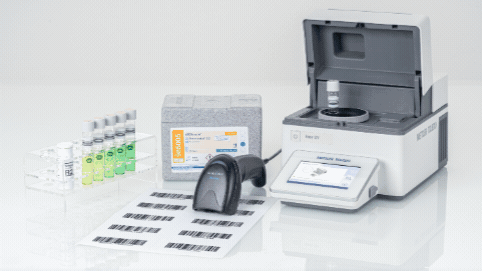Inorganic compounds play a vital role in water quality. Their presence or absence can significantly impact aquatic life, human health, and industrial processes. UV/Vis spectrophotometry can reliably determine the concentration of various inorganic substances.
Nitrate
Nitrate is a nitrogen-based compound commonly found in water bodies. While essential for plant growth in small amounts, excessive nitrate levels pose significant environmental and health risks. Nitrate contamination often originates from agricultural runoff, leaching from fertilizers, and wastewater discharges. High nitrate concentrations in drinking water can lead to serious health problems. Additionally, nitrate contributes to eutrophication, causing harmful algal blooms and oxygen depletion in water bodies. UV/Vis spectrophotometry is a widely used method for determining nitrate concentrations, enabling effective water quality monitoring and management.
Ammonia
Ammonia is a colorless gas with a pungent odor, often found in wastewater and agricultural runoff due to the decomposition of organic matter. High levels of ammonia are toxic to aquatic life, disrupting their respiratory systems. Moreover, ammonia can also contribute to eutrophication, again leading to oxygen depletion in water bodies. UV/Vis spectrophotometry, coupled with appropriate reagents, can accurately determine ammonia concentrations, enabling effective water quality management.
Fluoride
Fluoride is a mineral essential for dental health, preventing tooth decay. However, excessive fluoride consumption can lead to dental fluorosis and more severe skeletal fluorosis. Accurate fluoride measurement is crucial for maintaining optimal water quality and public health, not only in drinking water but also in dental products. UV/Vis spectrophotometry, through methods like the alizarin zirconyl complex analysis, enables precise fluoride determination in both water and dental products, ensuring compliance with safety standards.
Phosphate
Phosphates are essential nutrients for plant growth, including aquatic vegetation. However, excess phosphates can stimulate excessive plant growth, leading to imbalances in the ecosystem. UV/Vis spectrophotometry is widely used to monitor phosphate concentrations in water bodies.
Chloride
Chloride is a naturally occurring anion found in water. While essential for human health in moderate amounts, high chloride levels can impart a salty taste to water and contribute to corrosion of water infrastructure. Chloride contamination often originates from industrial discharges, saltwater intrusion, or road de-icing salts. UV/Vis spectrophotometry can be employed to monitor chloride levels effectively.
Arsenic
Arsenic is a toxic metalloid naturally occurring in some groundwater sources. It can also contaminate water through industrial activities and agricultural practices. Chronic exposure to arsenic can lead to various health issues, including skin lesions, respiratory problems, and an increased risk of cancer. UV/Vis spectrophotometry, combined with appropriate sample preparation techniques, can be used to detect and quantify arsenic in water.
Boron
Boron is an essential micronutrient for plants but can be toxic to humans at elevated levels. Naturally occurring in the environment, boron can find its way into water sources from various activities, including industrial processes, agriculture, and leaching from rocks and soil. Excessive boron consumption can affect reproductive health and development, particularly in children. Therefore, monitoring boron levels in water is crucial. UV/Vis spectrophotometry, combined with appropriate analytical methods, can accurately determine boron concentrations, ensuring water quality and public health.
Iron
Iron is an essential element for living organisms, but excessive levels in water can cause aesthetic problems such as discoloration and staining. Iron can also contribute to the growth of iron-bacteria, which can clog pipes and reduce water flow. UV/Vis spectrophotometry is a common method for determining iron concentrations in water, allowing for effective treatment and prevention of iron-related issues.
Copper
Copper is an essential trace element for human health, but excessive exposure can lead to copper poisoning, characterized by gastrointestinal symptoms, liver damage, and kidney problems. Copper can enter water bodies from industrial discharges, corrosion of copper pipes, and agricultural runoff. UV/Vis spectrophotometry can be utilized to monitor copper levels in water.
Magnesium
Magnesium is a vital mineral, contributing significantly to water hardness. While essential for human health, excessive magnesium can impact water quality and daily activities. Magnesium concentrations vary widely, with seawater containing significantly higher levels compared to freshwater sources. Maintaining optimal magnesium levels is crucial for preventing scale formation, ensuring efficient detergent performance, and safeguarding the longevity of water-based systems. UV/Vis spectrophotometry, combined with appropriate reagents, can accurately determine magnesium concentrations, aiding in water treatment and management.
Lead
Lead is a highly toxic metal with no known safe exposure level. It can accumulate in the body, causing severe health problems, particularly in children. Lead contamination in water often originates from old lead pipes, industrial discharges, and leaded gasoline. UV/Vis spectrophotometry can be employed as part of a comprehensive lead testing program to protect public health.


































